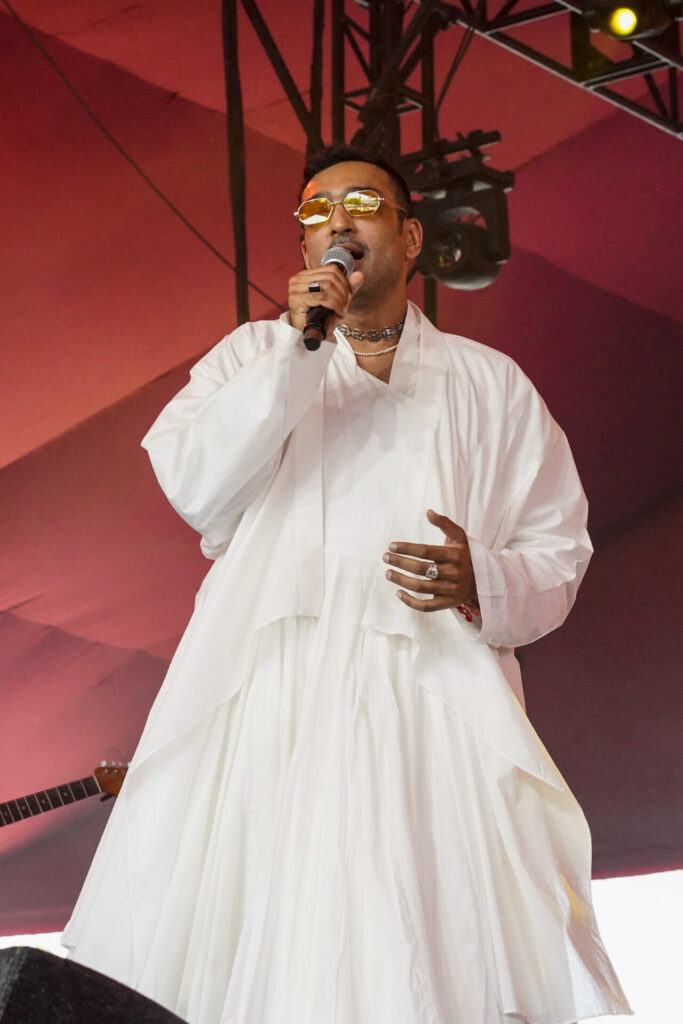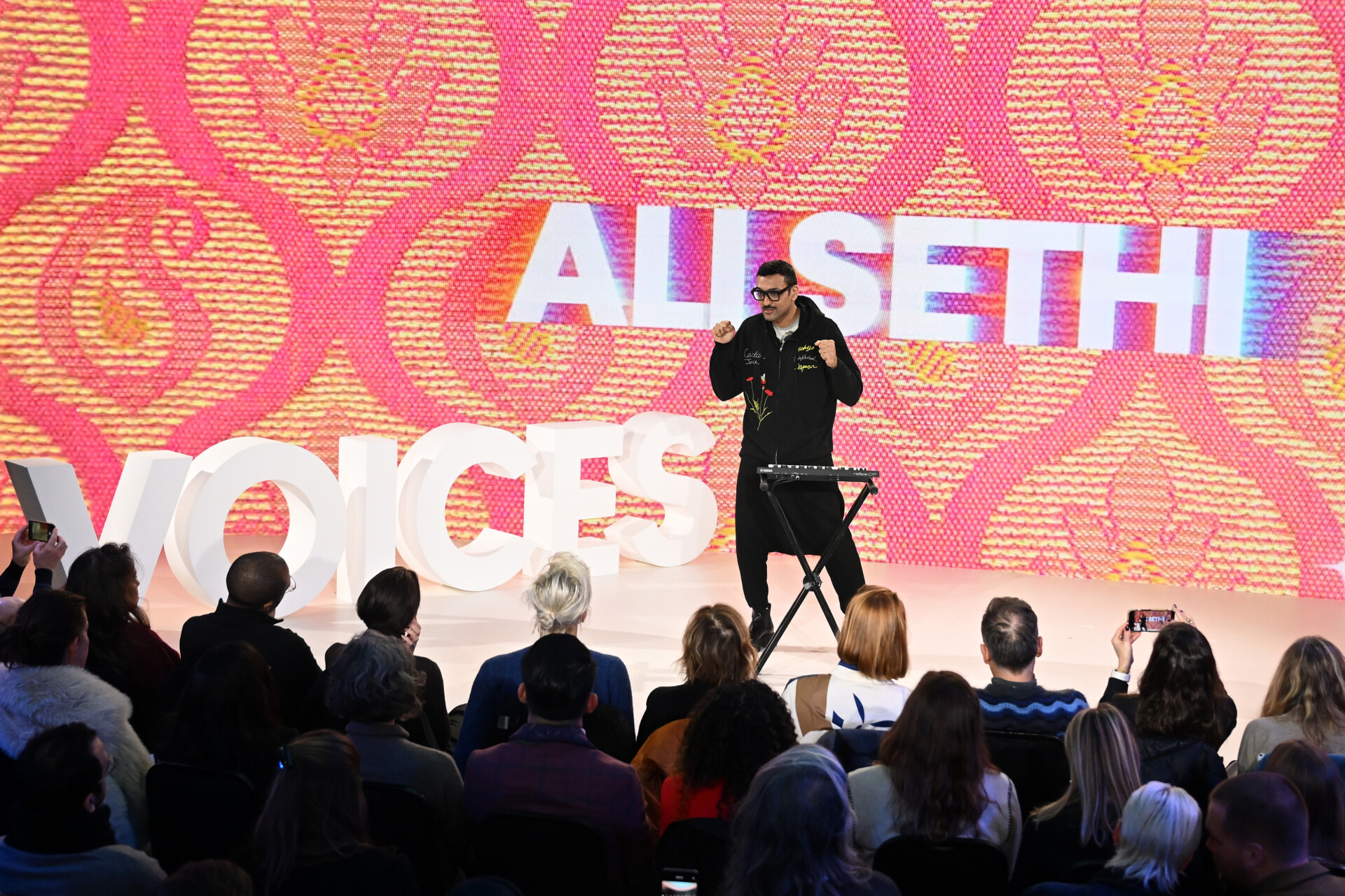Once celebrated on both sides of the India-Pakistan border, the Pakistani singer and composer Ali Sethi now finds himself estranged from his homeland, unwelcome in India and disillusioned with the United States, where he has lived and worked in recent years. After the April attack on tourists near Pahalgam in Kashmir, which India blamed on Pakistan-based groups, Sethi’s music and social media accounts were among those banned by the Indian government in a sweeping crackdown on Pakistani cultural exports. Visa restrictions on people of Pakistani origin now prevent him from visiting India altogether.
Yet Pakistan, where he was born and launched his musical career, no longer feels like home either. “After I came out and started expressing myself more and more, there was a kind of coordinated backlash from the right wing,” he told New Lines. Even the U.S., his current base, has started to feel hostile. “Suddenly, the fault lines are so sharp,” he said.
Despite being caught between borders, Sethi is among the most popular singers in the Pakistani — and broader South Asian — music scene. He has around a million monthly listeners on Spotify and shot to global popularity with his 2022 song “Pasoori,” which tallied almost a billion streams on YouTube and was the most searched song using Google’s “hum to search” function that year. The visibility made him one of the most internationally recognized Pakistani artists and put Pakistani music on the global map.
Sethi is a rare artist reinterpreting classical traditions for the modern age. Hindustani classical music enjoys respect and prestige, but its evolution is slow. While it retains a small but passionate following, the art form remains largely confined to niche festivals and music conferences, where the audience tends to skew older. That’s what makes Sethi’s story so interesting: His music, melding traditional vocal techniques with pop lyrics and viral sensibility, has connected with a younger audience more familiar with the catchy, 30-second music clips of TikTok.
In an interview with New Lines in New York, Sethi talked about the importance of adjusting — something he has had to do multiple times. “I don’t think of Hindustani classical music as an ossified tradition. I don’t look upon it and think: This is sealed, this is done, this is fixed,” he said.
Hindustani classical music, a centuries-old North Indian tradition built on intricate melodies and rhythms, is known for its deep improvisation and spiritual intensity. But the singer-composer often reinterprets it for a contemporary age, blending it with futuristic, genre-blurring pop sounds. For instance, on his first full album, “Love Language,” which he released last week, he draws from Hindustani classical music, Punjabi folk and Sufi chants and fuses them with flamenco, hip-hop and experimental electronic music — making him both traditional and transgressive at the same time.
Earlier, on his 2023 EP “Intiha” (“Final Point”), he collaborated with the Chilean-American producer Nicolas Jaar, blending Urdu poetry by greats like Mirza Ghalib, Faiz Ahmed Faiz and Allama Iqbal with dissonant synths, minimalist beats and experimental arrangements.
For Sethi, dissent takes shape through song and dance, continuing a tradition he grew up with in a society where direct speech often risks the anger and violence of the mob. “How could you say things that were risque, that were subversive?” Sethi asked. “You had to either say them through poems or you had to say them through songs. So those are all of the things I was thinking about when I started making the album,” he said. (One of the songs, “O Balama,” was originally recorded with a well-known Bollywood singer, but the track had to be redacted to remove the collaborator’s part after the diplomatic flare-up between India and Pakistan that began in April led to a ban on cross-border collaborations.)
Before stepping into the global spotlight, Sethi was known for reviving the “ghazal” tradition and reintroducing classical Urdu poetry to younger audiences. Ghazal is a form of poetry that originated in Arabic but has flourished in the Urdu literary tradition and explores themes of love, loss and longing.
In South Asia, it has long been associated with classical music, and examples of it have been performed by popular singers. But the form had faded from the mainstream by the early 2000s, until Sethi helped bring it back into public consciousness. One of his best-known renditions is “Ranjish Hi Sahi” (“If It Is Grief, So Be It”), his reinterpretation of a classic that was immortalized by the Pakistani singer Mehdi Hassan in the 1970s. Another standout is “Chandni Raat” (“Moonlit Night”) — a languid, dreamy rendition of a poem by the modernist Urdu poet Noon Meem Rashid.
His openness to experimentation stems in part from the way he was trained, he said. His teacher, Ustad Naseeruddin Saami, rooted him in the understanding that Hindustani classical music emerged not from purity but from pluralism. “He showed me that this music comes out of the multicultural melting pot that was precolonial India — all the way back to the 13th century,” Sethi recalled.
Sethi is also among the very few openly queer artists in South Asia at the moment. But he doesn’t need to be explicit about his queer sensibilities for his art to be read as such; queerness has long been woven into South Asian traditions — whether in the gender-blurring depictions of divine love in Bhakti and Sufi poetic traditions, the androgynous portrayals of mystics and saints in miniature paintings or the poetic ambiguity of the “beloved,” whose gender is often left deliberately undefined in ghazal and classical compositions.
“That’s what’s so incredible about it,” Sethi said. “I’ve been saying to people in America: It’s the original nonbinary perspective, right? In so many of our songs and poems, you don’t even know if the beloved is male or female. … If you look at depictions of the great mystics and saints in our miniature paintings, they’re androgynous figures — with long, overgrown hair, long nails, wearing tattered textiles. It’s not structured the way the West structures and constructs gender.”
He also points to the androgynous energy of “ragas” and “raginis,” the melodic frameworks in Hindustani classical music that are traditionally associated with specific moods, times of day and even genders. “They have this flirtatious, coquettish, almost androgynous quality,” he explained. “It’s a realm where men can express extreme delicacy and women can express extreme power.”
Sethi is often seen wearing skirts and flowing tunics in a bid to experiment with traditionally feminine silhouettes and androgynous styling. This has made him an important figure in South Asian queer fashion, as expressions of gender nonconformity are still rare in the mainstream. It is also the reason he gets trolled. Growing up in Pakistan, he remembers being surrounded by a heavy atmosphere of religious dogma. “People were constantly policing you — your behavior, your beliefs. And I remember feeling very bothered by that, even then.”
Now, he enjoys complicating people’s understanding of tradition. For his Coachella debut in 2023, Sethi wore a Mughal-inspired ensemble, a flowing “jama” — a long, robe-like garment that flares at the bottom — and layered it with an “angrakha,” a traditional, cross-tied tunic with an asymmetrical neckline. “This was me being folk and woke at the same time,” Sethi said. “Because on one hand, it is completely and utterly ancestral, and on the other hand, it’s completely subversive. I really get off on these little reconciliations wherever I can find them.”

Sethi is an important member of the Pakistani music scene, and the country’s music, its biggest cultural export, continues to find new audiences. For instance, Arooj Aftab, who became the first Pakistani to win a Grammy Award in 2022, has been performing at major venues and festivals around the world. Recently, the song “Jhol” from the 15th season of Coke Studio — a popular musical franchise, which has also played a role in Sethi’s rise — became a breakout hit and was featured on Spotify’s global playlist.
Sethi pointed out Pakistan’s lack of a centralized industry to shape its distinct creative landscape. “We don’t have an industry [like Bollywood] in Pakistan,” he said. “I think that’s what’s always given Pakistani musicians this paradoxical freedom — because there’s no pressure to conform.”
Unlike in India, where Bollywood has historically exerted a hegemonic influence over musical production, Pakistani music has remained largely independent, even for legendary figures like Nusrat Fateh Ali Khan and Abida Parveen, whose fame never relied on film soundtracks. “Ultimately, there’s no dominant musical style or sound that everyone has to fit into,” Sethi added. “And that’s allowed for a kind of experimentation and authenticity that might not survive in a more commercialized system.”
Apart from that, Sethi is also an important member of the South Asian community in New York City and regularly engages in cultural and political events. He performed for Zohran Mamdani, the Democratic Party’s nominee for the city’s mayoral elections. (Mamdani’s mother, the filmmaker Mira Nair, was responsible for giving Sethi one of his early breaks with a song in her film “The Reluctant Fundamentalist.”) He has also collaborated with the Indian novelist Amitav Ghosh and maintains friendships with the Nepalese-American designer Prabal Gurung. Sethi’s partner, Salman Toor, is an influential artist, renowned for his works that explore South Asian queer experiences.
But the unique and remarkable aspect of Sethi’s musical and creative journey is that he only began formal training in Hindustani classical music at the age of 17 — relatively late by South Asian standards — yet has managed to carve out a space for that tradition in the global cultural landscape.
Typically, artists who pursue classical forms in South Asia come from families with multigenerational ties to music, and their performances are largely confined to traditional, purist settings like “mehfils,” or music festivals. Sethi, however, has broken through those boundaries, both geographically and stylistically, and brought classical sensibilities into dialogue with contemporary aesthetics, digital platforms and global pop culture.
Coming of age in the post-9/11 world shaped Sethi’s worldview, especially given the binary imposed by President George W. Bush’s declaration that “Either you are with us, or you are with the terrorists,” which loomed large over Muslims globally and played a significant role in Sethi’s journey. He began his creative career in 2009 with “The Wish Maker,” a coming-of-age novel set in Pakistan after Gen. Muhammad Zia-ul-Haq’s dictatorship and the rise of social conservatism.
“I could have chosen the path of writing in English, for the West, and that option was very available to me,” Sethi said. But he wanted to be “enriched by, and in turn enrich, South Asian traditions. It wasn’t enough to just read Dickens and Chaucer and apply them to my life in abstract ways.”
“Looking back, I think that instinct served me well,” he said. “Because immersion in Hindustani music gave me something much deeper — a truly alternative epistemology. It’s not just music. It’s not just entertainment. People often treat it as some kind of cultural ornament. But it’s much more than that. It’s mind. It’s heart. It’s knowledge.”
Through songs, poetry and fashion, Sethi has challenged the binaries associated with gender, nation and genre. His art continues a long lineage of subversion through performance, while expanding the global reach of Pakistani music and South Asian queer expression.
Sign up to our mailing list to receive our stories in your inbox.



